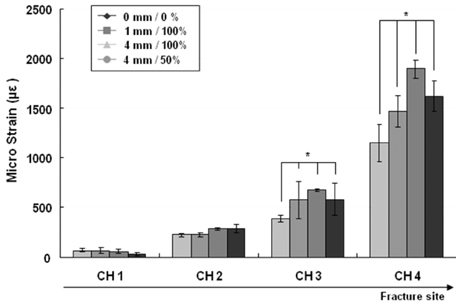J Korean Fract Soc.
2010 Apr;23(2):220-226. 10.12671/jkfs.2010.23.2.220.
Effect of Fracture Gap on Biomechanical Stability of Compression Bone-Plate Fixation System after Bone Fracture Augmentation
- Affiliations
-
- 1Senior Products Industrial Center, Busan Techno-park, Busan, Korea.
- 2Department of Biomedical Engineering, Inje University, Gimhae, Korea.
- 3Department of Radiologic Technology, Daegu Health College, Daegu, Korea.
- 4Department of Orthopedic Surgery, Korea University College of Medicine, Seoul, Korea. jkoh@korea.ac.kr
- KMID: 1461551
- DOI: http://doi.org/10.12671/jkfs.2010.23.2.220
Abstract
- PURPOSE
The goal of this study using the biomechanical test was to evaluate the mechanical stability of the bone-plate fixation system according to changes of the fracture gap sizes and widths.
MATERIALS AND METHODS
For mechanical test, four types with different fracture models simulating the clinical situations were constructed depending on the gap size (FGS, mm) and the gap width (FGW, %) at the fracture site: 0 mm/0%, 1 mm/100%, 4 mm/100%, 4 mm/50%. For analyzing the effects of fracture gap on the biomechanical stability of the bone-plate fixation system, 4-point bending test was performed under all same conditions.
RESULTS
It was found that the fracture gap sizes of 1 and 4 mm decreased mechanical stiffness by about 50~60% or more. Furthermore, even without fracture gap size, 50% or more fracture gap width considerably decreased mechanical stiffness and suggested the possibility of plate damage through strain results.
CONCLUSION
Our findings suggested that at least 50% contact of the fracture faces in a fracture surgery would be maintained to increase the mechanical stability of the bone-plate fixation system.
MeSH Terms
Figure
Reference
-
1. Baumgaertel F, Buhl M, Rahn BA. Fracture healing in biological plate osteosynthesis. Injury. 1998. 29:Suppl 3. C3–C6.
Article2. Cordey J, Borgeaud M, Perren SM. Force transfer between the plate and the bone: relative importance of the bending stiffness of the screws and the friction between plate and bone. Injury. 2000. 31:Suppl 3. C21–C28.
Article3. Frigg R. Locking compression plate (LCP). An osteosynthesis plate based on the Dynamic Compression Plate and Point Contact Fixator (PC-Fix). Injury. 2001. 32:Suppl 2. 63–66.
Article4. Gardner MJ, Brophy RH, Campbell D, et al. The mechanical behavior of locking compression plates compared with dynamic compression plates in a cadaver radius model. J Orthop Trauma. 2005. 19:597–603.
Article5. Gautier E, Perren SM, Cordey J. Effect of plate position relative to bending direction on the rigidity of a plate ostosynthesis. A theoretical analysis. Injury. 2000. 31:Suppl 3. C14–C20.6. Korner J, Diederichs G, Arzdorf M, et al. A biomechanical evaluation of methods of distal humerus fracture fixation using locking compression plate versus conventional reconstruction plates. J Orthop Trauma. 2004. 18:286–293.
Article7. Fulkerson E, Egol KA, Kubiak EN, Liporace F, Kummer FJ, Koval KJ. Fixation of diaphyseal fractures with segmental defects: a biomechanical comparison of locked and conventional plating techniques. J Trauma. 2006. 60:830–835.
Article8. Perren SM. Evolution of the internal fixation of long bone fracture. J Bone Joint Surg Br. 2002. 84:1093–1110.9. Ramakrishna K, Shidhar I, Sivashanker S, Khong KS, Ghista DN. Design of fracture fixation plate for necessary and sufficient bone stress shielding. JSME International Journal Series C. 2004. 47:1086–1094.
Article10. Sommer C, Gautier E, Müller M, Helfet DL, Wagner M. First clinical results of the locking compression plate (LCP). Injury. 2003. 34:Suppl 2. B43–B54.
Article11. Stoffel K, Dieter U, Stachowiak G, Gächter A, Kuster MS. Biomechanical testing of the LCP - how can stability in locked internal fixators be controlled? Injury. 2003. 34:Suppl 2. B11–B19.
Article12. Stoffel K, Stachowiak G, Forster T, Gächter A, Kuster M. Oblique screws at the plate ends increase the fixation strength in synthetic bone test medium. J Orthop Trauma. 2004. 18:611–616.
Article
- Full Text Links
- Actions
-
Cited
- CITED
-
- Close
- Share
- Similar articles
-
- A Finite Element Analysis of Biomechanical Stability of Compression Plate Fixation System in according to Existing of Fracture Gap after Bone Fracture Augmentation
- Study of the Plating Methods in the Experimental Model of Mandibular Subcondyle Fracture
- Observation of Compression Plate for Treatment of the Femoral Shaft Fractures
- Augmentation Plate Fixation for the Management of Long-bone Nonunion after Intramedullary Nailing
- Basic Study on the Effect of Korean Ginseng upon Fracture Healing of the Bone








